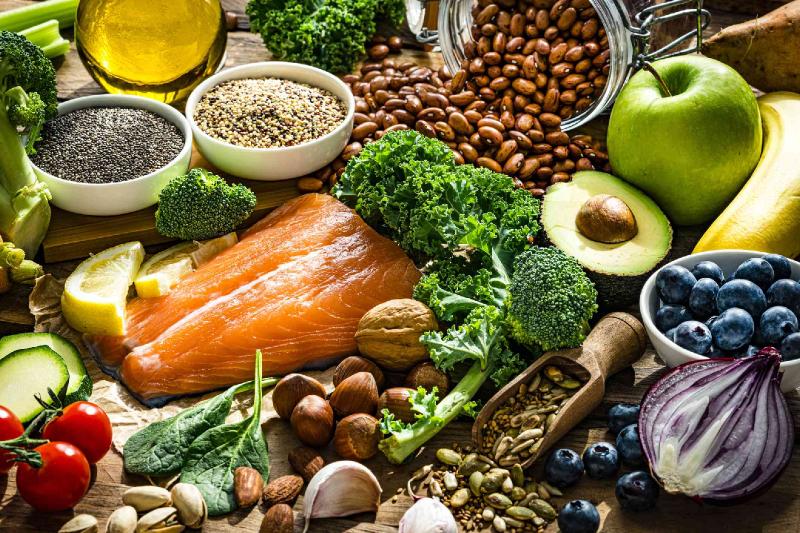17 High-Protein Foods That Beat a Protein Shake
By: Jillian Kubala (Health)


The latest fad diet in the spotlight is a 'high protein diet'. The Mediterranean diet has lost some of its pop culture luster. A high protein diet appears to be a better fit with social norms in the United States since it is essentially a meat-and-taters diet that includes more more meat and fewer taters.
Netizens and influencers like to focus attention on tuna and sardines. Those are readily available and affordable sources of protein. But there are many foods that can increase protein the diet. This article lists examples of common foods that are readily available.

Protein shakes are a popular way to pack in more protein between meals. Premade and homemade shakes usually contain 15-20 grams of protein, depending on the ingredients.
Though many people enjoy protein shakes, you may want other high-protein options to help you hit your daily protein goals.
Fortunately, many foods and drinks contain just as much, if not more, protein as protein shakes.
1. Cottage Cheese
- Protein: 23.5 grams per cup
Cottage cheese contains more protein than many protein shakes, packing 23.5 grams per cup. Cottage cheese can be used as a high-protein snack or added to foods like eggs, pancakes, and dips to boost their protein content.
In addition to protein, cottage cheese is rich in vitamins and minerals, like B12, calcium, and selenium.
2. Canned Tuna
- Protein: 20.1 grams per 3-ounce serving
Canned tuna contains 20.1 grams of protein per 3-ounce serving. It's also shelf-stable and can be purchased in bulk, so you always have a high-protein option on hand for snacking and preparing easy meals.
Canned tuna is an excellent option for people looking to increase their protein intake while keeping their carbohydrate intake low, such as those on low-carb diets, like the keto diet.
3. Chicken Breast
- Protein: 26 grams per 3-ounce serving
Chicken breast provides 26 grams of protein per 3-ounce serving, making it one of the best sources of protein you can eat. It's also a good source of essential vitamins and minerals like B vitamins, zinc, and selenium.
Chicken breast can be made into high-protein snacks, like chicken salad, and can be used as a protein source for simple, high-protein lunch and dinner recipes.
4. Shrimp
- Protein: 20.4 grams per 3-ounce serving
A 3-ounce serving of shrimp provides 20.4 grams of protein. Shrimp is also high in nutrients like vitamin B12, selenium, and astaxanthin, a powerful antioxidant that protects against cellular damage.
Shrimp is a great low-carbohydrate, high-protein addition to salads and stir-fries.
5. Ground Turkey
- Protein: 25.3 grams per 3-ounce serving
Ground turkey contains 25.3 grams of protein per three-ounce serving, more than what many protein shakes contain.
Turkey is a good source of B vitamins, like B6, which is needed for more than 100 enzymatic reactions in the body. It also contains zinc, which plays an essential role in your immunity.
6. Canned Salmon
- Protein: 19.6 grams per 3-ounce serving
A 3-ounce serving of canned salmon contains nearly 20 grams of high-quality protein.
Salmon is also rich in vitamins and minerals like B12, selenium, and potassium, as well as the omega-3 fats docosahexaenoic acid (DHA) and eicosapentaenoic acid (EPA). These help regulate inflammation and support your immunity.
Canned salmon is shelf-stable and more affordable than fresh salmon, making it a good choice for those on a budget.
7. Greek Yogurt
- Protein: 25 grams per cup
Greek yogurt provides more than twice the amount of protein found in regular yogurt, making it a better choice when trying to increase your protein intake.
It's also packed with essential nutrients like calcium, which gives the bones and teeth structure and regulates nerve and muscle function, hormone secretion, and blood vessel dilation.
8. Edamame
- Protein: 18.5 grams per cup
Edamame is packed with 18.5 grams of protein per cup, making it an excellent option for those on plant-based diets who want an easy source of protein to add to meals and snacks.
Edamame is also high in fiber, which supports and protects gut health, and folate, a B vitamin required for DNA synthesis, cellular division, and the maturation of red blood cells.
9. Seitan
- Protein: 15 grams per 3-ounce serving
Seitan is a plant-based protein source made from gluten, a group of proteins found in wheat.
Seitan contains 15 grams of protein per 3-ounce serving and has a chewy, meat-like texture. For these reasons, it's a popular vegan-friendly meat substitute for stir-fries, sandwiches, and more.
10. Navy Beans
- Protein: 19.7 grams per cup
With just under 20 grams of protein per cup, navy beans are one of the best sources of plant-based proteins you can eat.
Navy beans contain several vitamins and minerals but are especially high in folate, iron, selenium, and magnesium. Magnesium is a mineral needed for blood sugar and blood pressure regulation.
11. Tempeh
- Protein: 19.9 grams per 100g serving
Tempeh is a vegan-friendly protein source made from fermented soybeans. It contains 19.9 grams of protein per 100-gram serving. It's also a good source of B vitamins and minerals like iron, magnesium, and manganese.
Tempeh has a firm, meaty texture and can be used as a plant-based protein in vegetarian and vegan dishes.
12. Protein Bars
- Protein: 17 grams per bar
Protein bars are portable, easy to eat, and can be enjoyed in place of protein shakes.
The protein content of protein bars varies. It's important to read nutrition labels to ensure you choose a bar with at least 10 grams of protein per serving. For example, a Rise Vegan Sunflower Cinnamon Bar contains 17 grams of protein, making it a good option for increasing protein intake.
13. Lentils
- Protein: 17.9 grams per cup
Lentils are packed with protein, containing just under 18 grams per cup.
Lentils also provide fiber, B vitamins, and minerals like magnesium, zinc, iron, and potassium. Fiber is important for gastrointestinal and cardiovascular health.
14. Sardines
- Protein: 22.6 per 3.75-ounce can
Sardines are tiny fish that are exceptionally nutritious. A 3.75-ounce can of sardines contains 22.6 grams of protein, making sardines a solid choice for boosting your protein intake.
Sardines also contain several essential vitamins and minerals, like vitamin E, iron, B12, and calcium.
Sardines can be enjoyed on their own as a protein-rich snack or added to salads, soups, pasta, or pizza for a boost of protein.
15. Chicken Liver
- Protein: 20.8 grams per 3-ounce serving
Organ meats, like chicken liver, are high in protein. A 3-ounce serving of chicken liver contains 20.8 grams of protein and provides critical vitamins and minerals, like B12, vitamin A, iron, and folate.
Try adding chicken liver to salads and stir-fries, substituting it for more common protein sources like turkey, chicken, and steak.
16. Beef
- Protein: 23.5 grams per 3-ounce serving
Red meat, like beef, is one of the most protein-packed foods. Beef contains 23.5 grams of protein per 3-ounce serving and is rich in vitamins and minerals, like iron.
You can incorporate beef into many recipes, including burgers, pasta sauces, and sandwiches.
17. Cod
- Protein: 19.4 grams per 3-ounce serving
Cod is a mild-tasting fish that's high in protein. A 3-ounce serving provides 19.4 grams of protein, more than many protein shakes.
Cod also provides B vitamins and minerals like selenium and phosphorus, making it an all-around healthy choice.
A Quick Review
While protein shakes are a good source of protein, many other healthy foods contain as much, if not more.
Examples of protein-rich foods include cottage cheese, shrimp, tuna, Greek yogurt, lentils, chicken breast, navy beans, and salmon.

Tags
Who is online
38 visitors


Yes, beef is on the list, too. Sorry folks, the high protein diet works just as well for us omnivores as for vegans.
So, I drink protein shakes everyday. Comparing total protein in an arbitrarily chosen serving size is a little silly. What makes shakes amazing is they go down easy and have the highest protein per calorie of anything you can eat. A scoop of my whey protein powder is 28 grams of protein and 120 calories. Various varieties of fish come close to that, but nothing really equals it.
By all means, consume as much regular food as you can, but if you’re trying to get in higher quantities of protein and you feel like you can’t shove another thing in your stomach, the shakes are fantastic.
Additionally, I think a lot of people think protein shakes are not “real food.” They absolutely are - at least the ones I drink are. Whey protein is just what’s left over when you make cheese.
Brand? Source? Taste? C'mon, what are we missing?
I started drinking the premade ones. 30 grams for 150 calories. It's more convenient, fewer dishes and about the same cost. But I'm always on the lookout for a better source.
I was using Levels, which I chose for the short, clean ingredient list. Its only drawback was that it’s a whey concentrate. Whey concentrate has slightly more calories per gram of protein and tends to clump when you mix it.
Recently, I changed to Transparent Labs. It’s whey isolate, so it’s slightly less calories per gram of protein and mixes better. My options are limited because so many of these things are sweetened with Sucralose, to which I am allergic. The TL stuff (like Levels) is sweetened with stevia. Other than that, it’s a very short list of other natural ingredients.
They have a lot of flavors and I haven’t tried them all yet. I think the milk chocolate and vanilla flavors are pretty good. They have an oatmeal chocolate chip flavor that is good, but very sweet. The strawberry tastes like strawberry, but is a tad sour for my taste. Next up is cinnamon French toast. Stay tuned.
Another thing about these protein powders is that per gram of protein, they are the cheapest form of protein.
How are you mixing it? My son uses a shaker bottle. I'm all about the Ninja blender. Would that help with the clumping do you think?
I've used MusclePharm for years. I'll drink a Fairlife every now and then, or a Pure Protein premade.
I use a Helimix bottle. They mold it with a twist that is supposed to cause stirring as you shake. It’s pretty effective and I don’t have to mess with the metal ball that most bottles have. It’s definitely less hassle to clean than a blender, too.
"Fad". Where have people been? I've been on a high protein diet for 15 years.
The question is not how much protein per serving, it's how much protein per calorie.